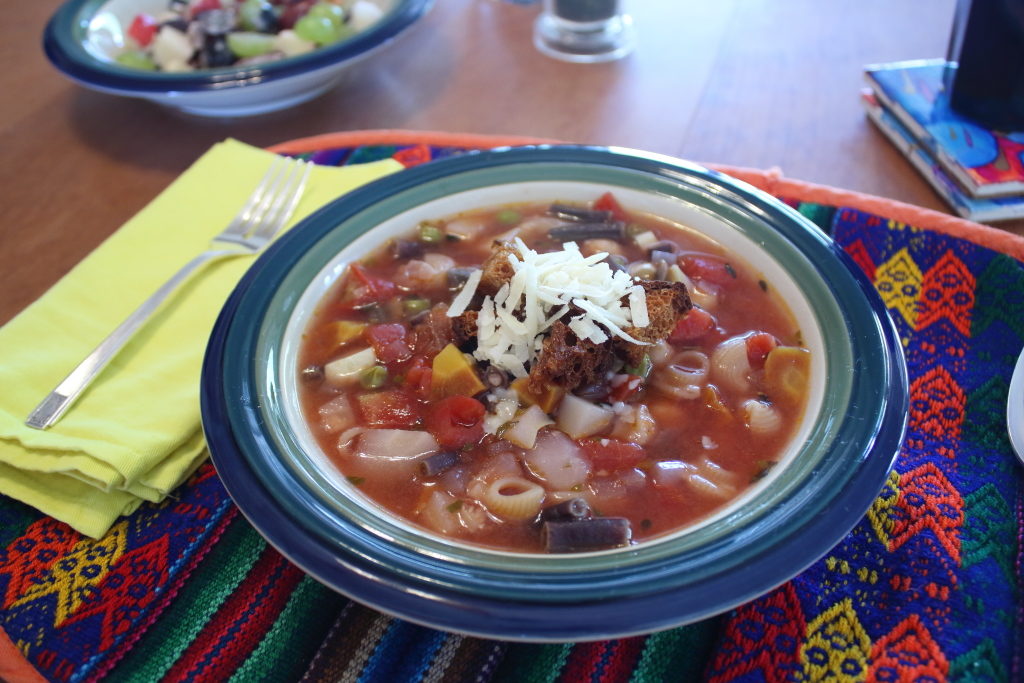
If we had to guess, we’d say there are probably a million versions of minestrone soup. We figure that every family in Italy has several versions, because it’s a soup that changes with the seasons and with the vegetables that are available. But, the basic idea is pretty much the same: make a very hearty tomato-based vegetable soup with a few beans and a handful of pasta. If you follow that, and put in vegetables that you like, we don’t think you can go wrong.
With that in mind, realize that we’d probably make this soup with different ingredients if we made it next week, and it would be more different next month, or the month after that. So, we figure that your soup will be different from ours, and that’s a good thing.
Minestrone Soup
Ingredients
- 2 Tbs extra-virgin olive oil
- 1/2 cup diced white onion
- Kosher salt
- Pinch red pepper flake
- Freshly ground black pepper
- 1 garlic clove finely minced
- 2 carrots peeled and cut into 1/2 inch pieces
- 6 long beans or about 12-15 green beans, cut into 1 inch pieces
- 4-5 mushrooms sliced
- 1 small summer squash diced
- 15 ounces diced tomatoes (1 can)
- 1/2 cup green peas
- 3-4 pieces Parmesan cheese rind
- 1 cup garbanzo beans with liquid
- 2 bay leaves
- 4 cups vegetable broth
- 1 Tbs dried oregano
- 1/2 Tbs dried basil
- 1/2 cup dried pasta
- 1-2 Tbs white wine vinegar
- Croutons for serving
- Grated Parmesan cheese for serving
Instructions
- Heat oil in a large saucepan over medium heat. Add onions, sprinkle with salt, red pepper flake, and black pepper. Cook, stirring occasionally, until tender and beginning to brown slightly, about 7 minutes. Add garlic and continue to cook until fragrant, another minute.
- Add ingredients listed through the vegetable broth and bring to a simmer. Cover, and simmer 30 minutes.
- Add oregano and basil and stir in. Simmer about 5 minutes.
- Stir in pasta and simmer until the pasta is done. Remove bay leaves and cheese rinds.
- Taste and season with vinegar, and salt and pepper, as needed.
- Serve topped with croutons and grated cheese.
Ingredient discussion:
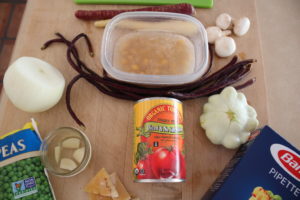
As we implied above, and now explicitly state: use fresh vegetables that you have on hand. The only vegetable we used that wasn’t fresh was peas, and that’s because we rarely get fresh peas, much to our disappointment. As a rule of thumb, you should be adding about 1/2 -3/4 of each chopped vegetable. Parmesan cheese rinds are, and should be, saved for dishes such as this. They add great flavor. All you need to do is freeze the rind after you grate away the softer cheese from the interior.
Procedure in detail:
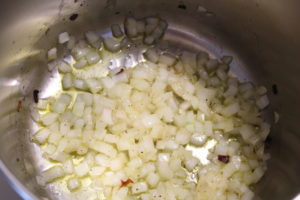
Cook aromatics. Heat oil in a large saucepan over medium heat. When hot, add the onions, give the pan a shake to distribute them and coat with oil, then sprinkle with salt, red pepper flake, — you decide the size of the pinch, and, therefore, the spiciness — and black pepper. Continue cooking, stirring or shaking the pan from time to time, until the onions are beginning to brown, about 7 minutes. Add the garlic and cook until fragrant, about a minute. We happened to have a bit of garlic confit left, so we used one of those cloves, mashing it into a paste. But, minced garlic is fine, too.
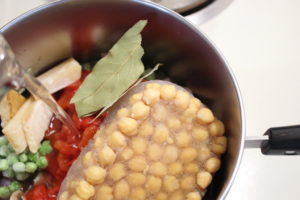
Add vegetables and simmer. Add whatever vegetables you’re using, along with the cheese rind, tomatoes, bay leaves, and vegetable broth. You don’t want to add the herbs quite yet, as extended simmering will reduce their flavor (the volatile oils will cook off). Bring the soup to a simmer. Cover and simmer for 30 minutes, or until everything is tender.
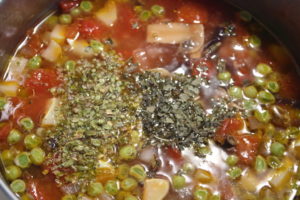
Add herbs and simmer. Stir in the oregano and basil and continue to simmer for another five minutes.
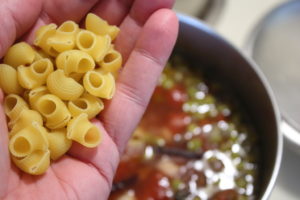
Add pasta and simmer. Look at the instructions for whatever pasta shape you’re using and add the pasta, timing it to be done when you want to serve the soup. At this time, you can remove the bay leaves and the cheese rinds. The rinds can be tricky to find, as they melt a bit and get covered with bits of vegetables.
Season. Once the pasta is done, stir in about a tablespoon of vinegar, taste, and season with more vinegar, salt, and pepper. The vinegar will help brighten up the flavor of the soup; once we learned this trick, we never make soup without adding just a bit of some sort of acid.
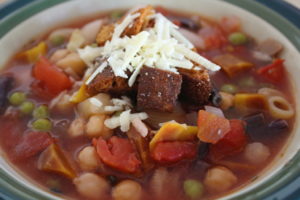
Serve. Ladle into bowls, top with a few croutons, followed by some grated cheese.
The hardest part of making this soup is washing and cutting up the vegetables. Once they’re in the pot, it’s just simmer, and add a few other ingredients as it gets closer to the time you’ll be serving. All told, it probably takes about an hour to have a nice hearty, nourishing soup on the table. Four stars.

